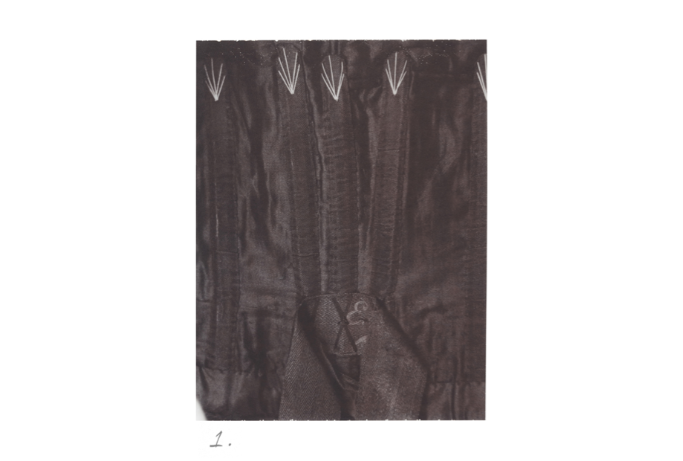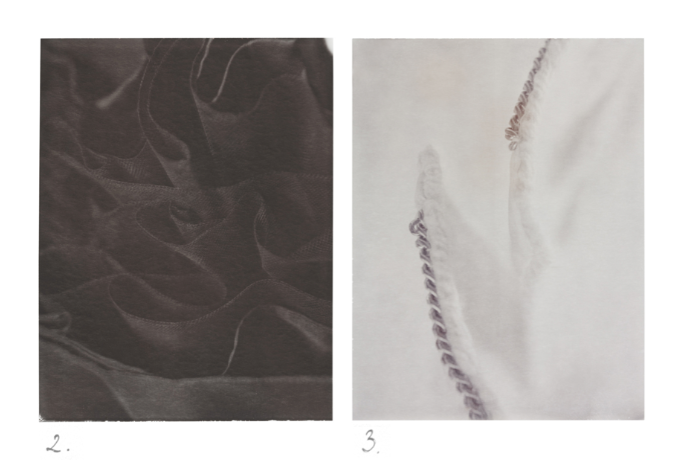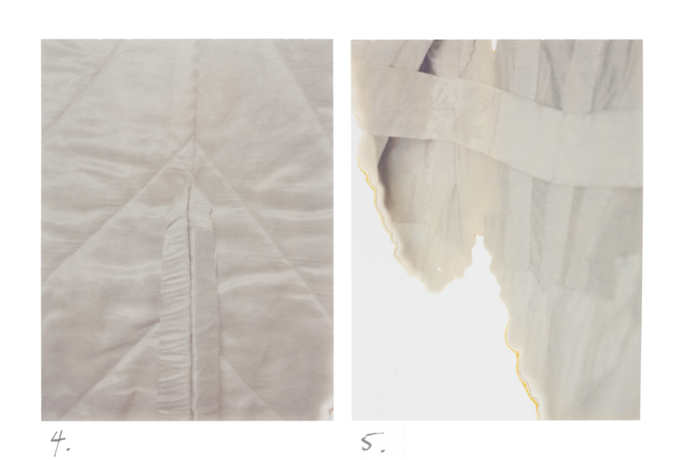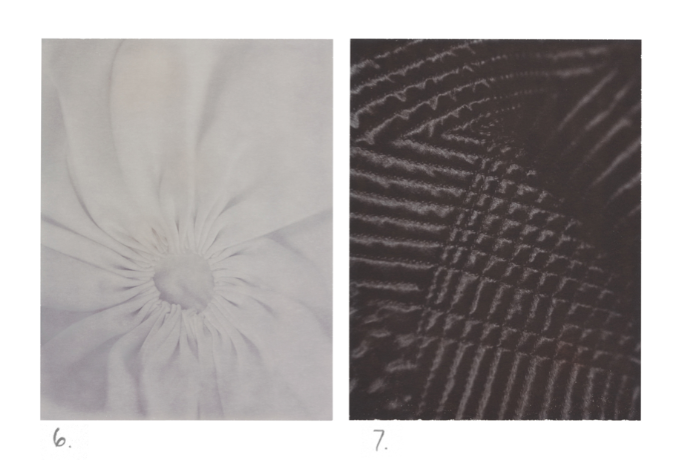IN A COLLABORATION WITH the National Gallery of Victoria, we explore the often-unseen spaces of a gallery archive with photographer Adam Custins and writer Winnie Ha. Following a selection of garments assembled by curator, Paola Di Trocchio, each unique with its own provenance, maker, wearer and cultural context. This first instalment of the diptych with an introduction by Paola Di Trocchio presents Adam Custins’ delicate photographs, shot on large-format Polaroid film (rare and discontinued stock) that reveal the architectural details that underpin the finished exterior of a garment.
These structural forms; internal belts, gathers, labels and immaculate stitching, are captured as abstract forms in Adam’s photographs, reminding us that a garment is a multi-faceted object that can be examined both in intimate detail, and as a stylised object or image in a gallery space. Looking at new ways of engaging with garments in an institutional archive, the series reveals and explores what is inevitably hidden from view in exhibiting and storing fashion objects. On closer inspection, these structural details force us to view garments as individual objects or artefacts, in absence of the body.
***
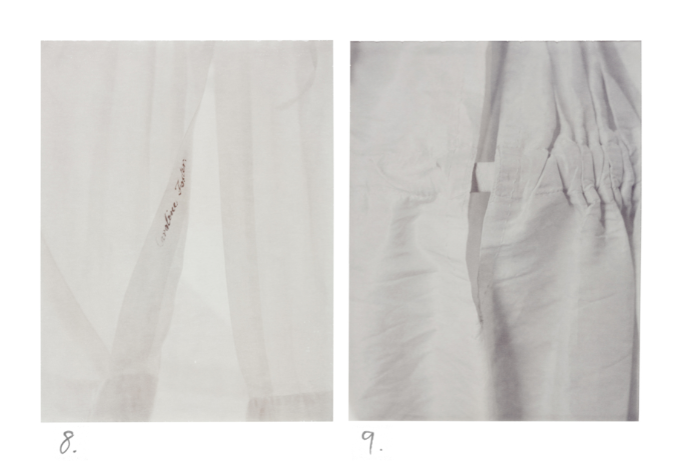
To create these images, the garments hung in the National Gallery of Victoria’s photographic studio like specimens. Draped from equipment and stands, prodded and propped with tripods, the objects were circled and inspected in detail, held in place with artificial arms wearing white gloves and tissue paper. The clock was ticking; six hours to photograph nine garments when about half-way through, the signature hand-stitched chain at the base of the Chanel jacket refused to cooperate, hanging dogmatically for much longer than the others, reigning over us with arrogant authority, like the grand Dame herself.
This was the setting that accompanied the project ‘Inside Out’, devised by Vestoj’s Laura Gardner following a visit to the NGV fashion and textiles store. Hung on individual coat hangers or flat in boxes, archival garments are disassociated from the body, affording them different views. As objects they can be turned, opened and uncovered, and their individual architectures discovered. These acts were mimicked in the photographic studio, as photographer Adam Custins peaked up through and into the interiors of garments, recording their structural forms on Polaroid film.
The project was inspired by a hat by the London-based milliner Stephen Jones, ‘Mr Whippy’, 1995 (National Gallery of Victoria, Melbourne) where white soft pleated fabric is piled lusciously on the brimmed form to create the impression of a soft-serve cone, complete with a glossy red cherry on top. Inside the crown, a neat ring gathers the silk lining to its centre. This single elegant detail sparked the concept for ‘Inside Out’: to reveal the hidden construction details of works in the NGV’s Fashion and Textiles collection and the internal scaffolding upon which a garment sits. Through collaboration, these undersides of a garment’s exterior are revealed with a photographer and a writer, reinterpreting the gallery archive.
In gallery display, the construction details of a garment are typically hidden from view. Insides are often filled with a mannequin, the outside view of the garment prioritised to replicate how the garment would be worn. Yet with or without mannequins, it can be difficult to provide two views simultaneously, to show the outside and the underside of the same form. To view the outside one looks at, to view the inside one looks in, as such, these two realms remain separate. ‘Inside Out’ aims to address this, positioning the viewer inside the garments, at times looking in, and at other times looking up. For Christian Dior, dresses were constructed like buildings,1 and, like buildings, garments can be traversed, to afford both an inside and outside view. This project aimed to traverse the garment interiors through the eye of the photographer, and inject the camera through the hollow garment to reveal and explore its scaffolding, hidden from view from the exterior.
Nine works from the nineteenth and twentieth centuries featuring critical and unexpected details of construction were selected from the NGV collection. Some construction details were predictable, such as the whalebone stays within a nineteenth century bodice. Other details were less predictable, such as the fine, contrasting, fan-like stitches at the top of these stays, or the hatched padding inside the chest of a man’s tail-coat from the 1930s – applied to enhance the pectorals and to improve the wearer’s form.
The project offered alternate views of the garment; the photographer’s lens, cropped, framed and lit to abstract and mystify the technical attributes. The forms were re-interpreted by Custins, revealing their unexpected beauty and inner secrets. Working with the confines of the limited stock of the Polaroid film format, each work was photographed merely once, twice at most, rare in the digital age. Added to that was the unpredictability of the film itself. As the last of its kind, it was aged and temperamental in the process of development, adding a capriciousness to each of the images as they were forced to surrender to the medium of the Polaroid, which brought with it elegance, charm and risk.
The outcome is an image series created by Custins that interprets the construction details of the garments into abstracted terrains, painterly textures and abstracted symmetrical marks. They provide an intimate view that allows viewers to traverse the internal spaces of garments, and seek the marks made for, and by, the absent body.
***
1. E. TERRY & SON, Southseaactive England 1900sDress c.1908viscose, rayon, cotton, glass(a) 49.0 cm (centre back) 53.0 cm (sleeve length) (bodice)(b) 121.0 cm (centre back) 34.8 cm (waist, flat) (skirt)National Gallery of Victoria, MelbourneGift of Miss P. Acklon, 1979 2. CHRISTIAN DIOR, Paris (couture house)French est. 1946Christian DIOR (designer)French 1905–1957Zelie, cocktail dress 1954 autumn-wintersilk122.0 cm (centre back) 32.0 cm (waist, flat)National Gallery of Victoria, MelbournePurchased NGV Foundation, 2006 3. CHANEL, Paris (couture house)French 1914–1939, 1954-Gabrielle ‘Coco’ CHANEL (designer)French 1883–1971Suit 1970 spring-summersilk, wool, brass, metal(a) 64.0 cm (centre back) 58.2 cm (sleeve length) (jacket)(b) 64.0 cm (centre back) 38.5 cm (waist, flat) (skirt)National Gallery of Victoria, MelbourneGift of Mavis Powell, 1986 4. ENGLANDDolman 1880silk, metal, elastic53.0 cm (centre back) 55.2 cm (sleeve length)National Gallery of Victoria, MelbournePresented by Mrs Gordon Landy, 1983 5. MDME BRONTE, London (dressmaker)English active 1890sEmma Jane EXLEY (designer)active 1890sAfternoon dress c.1895silk, ballen, metal hooks141.5 cm (centre back) 30.0 cm (waist, flat)National Gallery of Victoria, MelbourneThe Schofield Collection. Purchased with the assistance of a special grant from the Government of Victoria, 1974 6. STEPHEN JONES, London (milliner)English est. 1980Stephen JONES (designer)born England 1957‘Mr Whippy’, hat 1995 spring-summer, Legasty collectionpolyester, silk, synthetic sparterie, metal, paint150.0 cm (outer circumference) 28.0 cm (height) 49.4 cm (width)National Gallery of Victoria, MelbournePurchased, 1996 7. TAGNEY & RANDELL, London(tailor)English 1845–1948Tail coat c.1935wool, silk, linen113.5 cm (centre back) 64.0 cm (sleeve length)National Gallery of Victoria, MelbourneGift of Mr J. McG. Edwards, 1979 8. ENGLANDPelisse and dress c.1818cotton, silk metal (buttons and hook and eye)(a) 141.0 cm (centre back) 66.0 cm (sleeve length) (pelisse)(b) 4.8 cm x 4.8 cm (ribbon) (c) 136.0 cm (centre back) 35.0 cm (waist, flat) (dress)National Gallery of Victoria, MelbourneThe Schofield Collection. Purchased with the assistance of a special grant from the Government of Victoria, 1974 9. ENGLANDWedding gown c.1885silk, cotton, balleenNational Gallery of Victoria, MelbourneGift of Mrs Sister Winifred Hurley, 1962
Christian Dior, ‘Dior by Dior’, 1958, p.21-22 ↩
